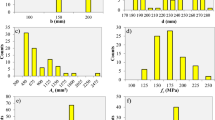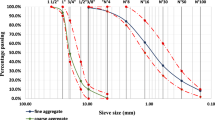Abstract
Construction production (industry) is the biggest natural resource user, and environmental sustainability is threatened. The environmental and economic concern is the most important challenge the construction industry (concrete and mortar) faces. In this article, the economic and environmental problems are dealt with by the use of waste glass as a partial replacement of fine aggregates in a mortar by using fly ash and granulated blast furnace slag (GGBS); for that reason, 116 data are collected from previous paper with different parameter and statically analyzed, and represented in three models (Linear regression model (LRM), non-linear regression model (NLRM) and Artificial neural network (ANN)) for predicted compressive strength of mortar and correlation to predict flexural strength. In the modeling process, these variables are important and affect the value of compressive strength, such as curing time, w/c, cement content, sand content, fly ash, GGBS, and waste glass content. Various statistical assessments such as Root Mean Squared Error (RMSE), Mean Absolute Error (MAE), Scatter Index (SI), OBJ value, and the coefficient of determination (R2) were used to evaluate the efficiency and performance of the proposed models. The obtained results showed that the ANN-model showed better efficiency for predicting the compressive strength of mortar mixtures containing fine glass compared to the LR and NLR model. The SI and OBJ values of the LR model were 81% and 166% higher than the ANN model, and for NLR were 71% and 124% higher than the ANN model. The correlation between measured compressive strength and flexural strength was with an R-square value of 0.76.

























Similar content being viewed by others
Availability of the data and materials
All data generated or analysed during this study are included in this published article.
References
Ahmad, S. A., Ahmed, H. U., Ahmed, D. A., Hamah-ali, B. H. S., Faraj, R. H., & Rafiq, S. K. (2023). Predicting concrete strength with waste glass using statistical evaluations, neural networks, and linear/nonlinear models. Asian Journal of Civil Engineering, 2, 1–13.
Ahmad, S. A., & Rafiq, S. K. (2022). Evaluating the effect of waste glass on the fresh and mechanical properties of mortar: A review. Sulaimania Journal for Engineering Sciences, 9(1), 2.
Ahmad, S. A., Rafiq, S. K., Ahmed, H. U., Abdulrahman, A. S., & Ramezanianpour, A. M. (2023). Innovative soft computing techniques including artificial neural network and nonlinear regression models to predict the compressive strength of environmentally friendly concrete incorporating waste glass powder. Innovative Infrastructure Solutions, 8(4), 119.
Bostanci, L. (2020). Effect of waste glass powder addition on properties of alkali-activated silica fume mortars. Journal of Building Engineering, 29, 101154.
Cabrera Covarrubias, F. G., Gómez Soberón, J. M. V., Almaral Sánchez, J. L., Corral Higuera, R., Navarro Ezquerra, A., & Tous Coll, M. (2014). Characterization of three recycled materials for alternative use of mortars. In CSCE International Conference on Advances In Civil, Structural And Construction Engineering (pp. 69–73).
Cabrera-Covarrubias, F. G., Gomez-Soberon, J. M., Almaral-Sanchez, J. L., Arredondo-Rea, S. P., & Mendivil-Escalante, J. M. (2018). Mechanical and basic deformation properties of mortar with recycled glass as a fine aggregate replacement. International Journal of Civil Engineering, 16(1), 107–121.
Calmon, J. L., Sauer, A. S., Vieira, G. L., & Teixeira, J. E. S. L. (2014). Effects of windshield waste glass on the properties of structural repair mortars. Cement and Concrete Composites, 53, 88–96.
Choi, S. Y., Choi, Y. S., & Yang, E. I. (2017). Effects of heavy weight waste glass recycled as fine aggregate on the mechanical properties of mortar specimens. Annals of Nuclear Energy, 99, 372–382.
Choi, S. Y., Choi, Y. S., & Yang, E. I. (2018). Characteristics of volume change and heavy metal leaching in mortar specimens recycled heavyweight waste glass as fine aggregate. Construction and Building Materials, 165, 424–433.
Corinaldesi, V., Nardinocchi, A., & Donnini, J. (2016). Reuse of recycled glass in mortar manufacturing. European Journal of Environmental and Civil Engineering, 20(sup1), s140–s151.
Flores-Ales, V., Alducin-Ochoa, J. M., Martín-del-Río, J. J., Torres-Gonzalez, M., & Jimenez-Bayarri, V. (2020). Physical-mechanical behaviour and transformations at high temperature in a cement mortar with waste glass as aggregate. Journal of Building Engineering, 29, 101158.
Flores-Alés, V., Martín-del-Río, J. J., Alducin-Ochoa, J. M., & Torres-González, M. (2020). Rehydration on high temperature-mortars based on recycled glass as aggregate. Journal of Cleaner Production, 275, 124139.
Gómez-Soberón, J. M., Cabrera-Covarrubias, F. G., Almaral- Sánchez, J. L., & Gómez-Soberón, M. C. (2018). Fresh-state properties of mortars with recycled glass aggregates: Global unification of behavior. Advances in Materials Science and Engineering, 20, 18.
Guo, M. Z., Tu, Z., Poon, C. S., & Shi, C. (2018). Improvement of properties of architectural mortars prepared with 100% recycled glass by CO2 curing. Construction and Building Materials, 179, 138–150.
He, P., Zhang, B., Lu, J. X., & Poon, C. S. (2020a). ASR expansion of alkali-activated cement glass aggregate mortars. Construction and Building Materials, 261, 119925.
He, P., Zhang, B., Yang, S., Ali, H. A., Lu, J. X., & Poon, C. S. (2020b). Recycling of glass cullet and glass powder in alkali-activated cement: Mechanical properties and alkali-silica reaction. Waste and Biomass Valorization, 11, 7159–7169.
Kaveh, A., Gholipour, Y., & Rahami, H. (2008). Optimal design of transmission towers using genetic algorithm and neural networks. International Journal of Space Structures, 23(1), 1–19.
Kaveh, A., & Iranmanesh, A. (1998). Comparative study of backpropagation and improved counterpropagation neural nets in structural analysis and optimization. International Journal of Space Structures, 13, 177–185.
Kaveh, A., & Khalegi, A. (1998). Prediction of strength for concrete specimens using artificial neural network. Asian Journal of Civil Engineering, 2(2), 1–13.
Kaveh, A., & Khavaninzadeh, N. (2023). Efficient training of two ANNs using four meta-heuristic algorithms for predicting the FRP strength. In Structures, 52, 256–272.
Ling, T. C., & Poon, C. S. (2011). Utilization of recycled glass derived from cathode ray tube glass as fine aggregate in cement mortar. Journal of Hazardous Materials, 192(2), 451–456.
Ling, T. C., & Poon, C. S. (2012). A comparative study on the feasible use of recycled beverage and CRT funnel glass as fine aggregate in cement mortar. Journal of Cleaner Production, 29, 46–52.
Ling, T. C., & Poon, C. S. (2013). Effects of particle size of treated CRT funnel glass on properties of cement mortar. Materials and Structures, 46(1), 25–34.
Ling, T. C., & Poon, C. S. (2017). Spent fluorescent lamp glass as a substitute for fine aggregate in cement mortar. Journal of Cleaner Production, 161, 646–654.
Ling, T. C., Poon, C. S., Lam, W. S., Chan, T. P., & Fung, K. K. L. (2012). Utilization of recycled cathode ray tubes glass in cement mortar for X-ray radiation-shielding applications. Journal of Hazardous Materials, 199, 321–327.
Long, W. J., Li, H. D., Ma, H., Fang, Y., & Xing, F. (2019). Green alkali-activated mortar: Sustainable use of discarded cathode-ray tube glass powder as precursor. Journal of Cleaner Production, 229, 1082–1092.
Lu, J. X., Zhan, B. J., Duan, Z. H., & Poon, C. S. (2017). Using glass powder to improve the durability of architectural mortar prepared with glass aggregates. Materials & Design, 135, 102–111.
Małek, M., Łasica, W., Jackowski, M., & Kadela, M. (2020). Effect of waste glass addition as a replacement for fine aggregate on properties of mortar. Materials, 13(14), 3189.
Oliveira, R., de Brito, J., & Veiga, R. (2015). Reduction of the cement content in rendering mortars with fine glass aggregates. Journal of Cleaner Production, 95, 75–88.
Sikora, P., Augustyniak, A., Cendrowski, K., Horszczaruk, E., Rucinska, T., Nawrotek, P., & Mijowska, E. (2016). Characterization of mechanical and bactericidal properties of cement mortars containing waste glass aggregate and nanomaterials. Materials, 9(8), 701.
Sudharsan, N., Palanisamy, T., & Yaragal, S. C. (2018). Environmental sustainability of waste glass as a valuable construction material—A critical review. Ecology, Environment and Conservation, 24, S331–S338.
Tuaum, A., Shitote, S., & Oyawa, W. (2018). Experimental study of self-compacting mortar incorporating recycled glass aggregate. Buildings, 8(2), 15.
Yang, S., Poon, C. S., & Ling, T. C. (2019). Distribution of ASR gel in conventional wet-mix glass mortars and mechanically produced dry-mix glass blocks. Construction and Building Materials, 229, 116916.
Zhang, B., He, P., & Poon, C. S. (2020). Optimizing the use of recycled glass materials in alkali activated cement (AAC) based mortars. Journal of Cleaner Production, 255, 120228.
Zhang, L., & Yue, Y. (2018). Influence of waste glass powder usage on the properties of alkali-activated slag mortars based on response surface methodology. Construction and Building Materials, 181, 527–534.
Zhao, H., & Poon, C. S. (2017). A comparative study on the properties of the mortar with the cathode ray tube funnel glass sand at different treatment methods. Construction and Building Materials, 148, 900–909.
Funding
Not applicable.
Author information
Authors and Affiliations
Contributions
we did the work together and reviewed the work together
Corresponding author
Ethics declarations
Conflict of interest
We wish to confirm that there are no known conflicts of interest associated with this publication, and there has been no significant support for this work that could have influenced its outcome.
Research involving human/animal participants
This article does not contain any studies involving animal or human participants performed by any of the authors.
Additional information
Publisher's Note
Springer Nature remains neutral with regard to jurisdictional claims in published maps and institutional affiliations.
Rights and permissions
Springer Nature or its licensor (e.g. a society or other partner) holds exclusive rights to this article under a publishing agreement with the author(s) or other rightsholder(s); author self-archiving of the accepted manuscript version of this article is solely governed by the terms of such publishing agreement and applicable law.
About this article
Cite this article
Ahmad, S.A., Rafiq, S.K. Numerical modeling to predict the impact of granular glass replacement on mechanical properties of mortar. Asian J Civ Eng 25, 19–37 (2024). https://doi.org/10.1007/s42107-023-00753-8
Received:
Accepted:
Published:
Issue Date:
DOI: https://doi.org/10.1007/s42107-023-00753-8




